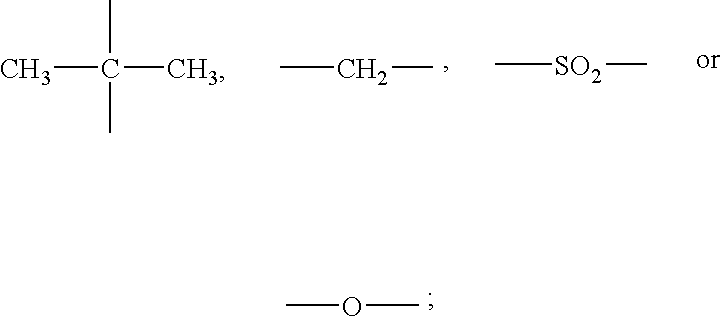Inkjet recording element comprising polyester ionomer and a method of use
a technology of polyester ionomer and inkjet recording element, which is applied in the direction of printing, coating, thermal imaging, etc., can solve the problems of limited commercial usefulness, difficult to achieve simultaneous requirements of inkjet recording media, and limited commercial usefulness, and achieves fast drying, good density, and low coalescence.
- Summary
- Abstract
- Description
- Claims
- Application Information
AI Technical Summary
Benefits of technology
Problems solved by technology
Method used
Image
Examples
example 1
[0114]A two-layered polyester microvoided substrate comprising an impermeable base polyester layer and an ink-permeable upper polyester layer is prepared in the following manner. The materials used in the preparation are:[0115]1) a poly(ethylene terephthalate) (PET) resin (IV=0.70 dl / g) for the base layer;[0116]2) a compounded blend consisting of 14.5% by weight of a sulphonated polyester (Eastman Chemical's AQ 55S®, Diglycol / CHDM / Isophthalates / SIP copolymer), 43.5% by weight poly(ethylene terephthalate) (PET) resin (IV=0.70 dl / g), and 42% by weight of cross-linked PMMA microbeads approximately 1.7 um in size for the top layer.
[0117]The cross-linked PMMA microbeads were compounded with the AQ 55S® and the PET resins through mixing in a counter-rotating twin-screw extruder attached to a pelletizing die. The resins were dried at 65° C. and fed by two plasticating screw extruders into a coextrusion die manifold to produce a two-layered melt stream which was rapidly quenched on a chill ...
example 2
[0119]A two-layered polyester microvoided substrate comprising an impermeable base polyester layer and an ink-permeable upper polyester layer is prepared in the following manner. The materials used in the preparation are:[0120]1) a poly(ethylene terephthalate) (PET) resin (IV=0.70 dl / g) for the base layer;[0121]2) a compounded blend consisting of 29% by weight of a sulphonated polyester (Eastman Chemical's AQ 55S®, Diglycol / CHDM / Isophthalates / SIP copolymer), 29% by weight poly(ethylene terephthalate) (PET) resin (IV=0.70 dl / g), and 42% by weight of cross-linked PMMA microbeads approximately 1.7 um in size for the top layer.
[0122]The cross-linked PMMA microbeads were compounded with the AQ 55S® and the PET resins through mixing in a counter-rotating twin-screw extruder attached to a pelletizing die. The resins were dried at 65° C. and fed by two plasticating screw extruders into a coextrusion die manifold to produce a two-layered melt stream which was rapidly quenched on a chill roll...
example 3
[0124]A two-layered polyester microvoided substrate comprising an impermeable base polyester layer and an ink-permeable upper polyester layer is prepared in the following manner. The materials used in the preparation are:[0125]1) a poly(ethylene terephthalate) (PET) resin (IV=0.70 dl / g) for the base layer;[0126]2) a compounded blend consisting of 14.5% by weight of a sulphonated polyester (Eastman Chemical's AQ 55S®, Diglycol / CHDM / Isophthalates / SIP copolymer), 43.5% by weight PETG 6763® resin (IV=0.73 dl / g) (Eastman Chemical Company), and 42% by weight of cross-linked PMMA microbeads approximately 1.7 um in size for the top layer.
[0127]The cross-linked PMMA microbeads were compounded with the AQ 55S® and the PET resins through mixing in a counter-rotating twin-screw extruder attached to a pelletizing die. The resins were dried at 65° C. and fed by two plasticating screw extruders into a coextrusion die manifold to produce a two-layered melt stream which was rapidly quenched on a chi...
PUM
| Property | Measurement | Unit |
|---|---|---|
| particle size | aaaaa | aaaaa |
| thickness | aaaaa | aaaaa |
| thickness | aaaaa | aaaaa |
Abstract
Description
Claims
Application Information
 Login to View More
Login to View More - R&D
- Intellectual Property
- Life Sciences
- Materials
- Tech Scout
- Unparalleled Data Quality
- Higher Quality Content
- 60% Fewer Hallucinations
Browse by: Latest US Patents, China's latest patents, Technical Efficacy Thesaurus, Application Domain, Technology Topic, Popular Technical Reports.
© 2025 PatSnap. All rights reserved.Legal|Privacy policy|Modern Slavery Act Transparency Statement|Sitemap|About US| Contact US: help@patsnap.com



